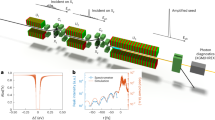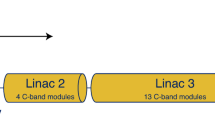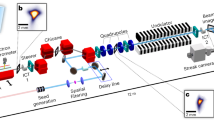Abstract
A self-seeded X-ray free-electron laser (XFEL) is a promising approach to realize bright, fully coherent free-electron laser (FEL) sources in the hard X-ray domain that have been a long-standing issue with longitudinal coherence remaining challenging. At the Pohang Accelerator Laboratory XFEL, we have demonstrated a hard X-ray self-seeded XFEL with a peak brightness of 3.2 × 1035 photons s–1 mm–2 mrad–2 0.1% bandwidth (BW)–1 at 9.7 keV. The bandwidth (0.19 eV) is about 1/70 times as wide (close to the Fourier transform limit) and the peak spectral brightness is 40 times higher than in self-amplified spontaneous emission (SASE), with substantial improvements in the stability of self-seeding and noticeably suppressed pedestal effects. We could reach an excellent self-seeding performance at a photon energy of 3.5 keV (lowest) and 14.6 keV (highest) with the same stability as the 9.7 keV self-seeding. The bandwidth of the 14.6 keV seeded FEL was 0.32 eV, and the peak brightness was 1.3 × 1035 photons s–1 mm–2 mrad–2 0.1%BW–1. We show that the use of seeded FEL pulses with higher reproducibility and a cleaner spectrum results in serial femtosecond crystallography data of superior quality compared with data collected using SASE mode.
This is a preview of subscription content, access via your institution
Access options
Access Nature and 54 other Nature Portfolio journals
Get Nature+, our best-value online-access subscription
$29.99 / 30 days
cancel any time
Subscribe to this journal
Receive 12 print issues and online access
$209.00 per year
only $17.42 per issue
Buy this article
- Purchase on Springer Link
- Instant access to full article PDF
Prices may be subject to local taxes which are calculated during checkout





Similar content being viewed by others
Data availability
The raw data CXI files and geometry files have been deposited in the Coherent X-ray Imaging Data Bank (CXIDB; https://www.cxidb.org/). The coordinates and structural factors have been deposited in the Research Collaboratory for Structural Bioinformatics (RCSB) under the accession codes 7BYO/7D01/7D04 (for lysozyme from the self-seeded mode) and 7BYP/7D02/7D05 (for lysozyme from the SASE mode). The data that support the plots within this paper and other findings of this study are available from the corresponding authors upon reasonable request.
Code availability
The line plots, dot plots and bar graphs reported in Fig. 5, Supplementary Fig. 6 and Supplementary Fig. 7 were made based on the calculation results using version 0.9.1 of the CrystFEL suite available at https://www.desy.de/~twhite/crystfel/.
Change history
04 June 2021
A Correction to this paper has been published: https://doi.org/10.1038/s41566-021-00840-9
References
Emma, P. et al. First lasing and operation of an ångstrom-wavelength free-electron laser. Nat. Photon. 4, 641–647 (2010).
Tanaka, H. et al. A compact X-ray free-electron laser emitting in the sub-ångström region. Nat. Photon. 6, 540–544 (2012).
Kang, H.-S. et al. Hard X-ray free-electron laser with femtosecond-scale timing jitter. Nat. Photon. 11, 708–713 (2017).
Decking, W. et al. A MHz-repetition-rate hard X-ray free-electron laser driven by a superconducting linear accelerator. Nat. Photon. 14, 391–397 (2020).
Prat, E. et al. A compact and cost-effective hard X-ray free-electron laser driven by a high-brightness and low-energy electron beam. Nat. Photon. 14, 748–754 (2020).
Callegari, C, et al. Atomic, molecular and optical physics applications of longitudinally coherent and narrow bandwidth free-electron lasers. Phys. Rep. https://doi.org/10.1016/j.physrep.2020.12.002 (2021).
Adams, B. et al. Scientific opportunities with an X-ray free-electron laser oscillator. Preprint at https://arxiv.org/abs/1903.09317 (2019).
Abbamonte, P. et al. New Science Opportunities Enabled by LCLS-II X-ray Lasers SLAC-R-1053, 3–189 (SLAC National Accelerator Laboratory, 2015).
Yu, L.-H. et al. High-gain harmonic-generation free-electron laser. Science 289, 932–934 (2000).
Stupakov, G. Using the beam-echo effect for generation of short-wavelength radiation. Phys. Rev. Lett. 102, 074801 (2009).
Ribič, P. R. et al. Coherent soft X-ray pulses from an echo-enabled harmonic generation free-electron laser. Nat. Photon. 13, 555–561 (2019).
Feldhaus, J., Saldin, E. L., Schneider, J. R., Schneidmiller, E. A. & Yurkov, M. V. Possible application of X-ray optical elements for reducing the spectral bandwidth of an X-ray SASE FEL. Opt. Commun. 140, 341–352 (1997).
Saldin, E. L., Schneidmiller, E. A., Shvyd’ko, Yu. V. & Yurkov, M. V. X-ray FEL with a meV bandwidth. Nucl. Instrum. Methods Phys. Res. A 475, 357–362 (2001).
Geloni, G., Kocharyan, V. & Saldin, E. A novel self-seeding scheme for hard X-ray FELs. J. Mod. Opt. 58, 1391–1403 (2011).
Shvyd’ko, Yu. V. & Lindberg, R. R. Spatiotemporal response of crystals in X-ray Bragg diffraction. Phys. Rev. ST Accel. Beams 15, 100702 (2012).
Lindberg, R. R. & Shvyd’ko, Yu. V. Time dependence of Bragg forward scattering and self-seeding of hard X-ray free-electron lasers. Phys. Rev. ST Accel. Beams 15, 050706 (2012).
Amann, J. et al. Demonstration of self-seeding in a hard-X-ray free-electron laser. Nat. Photon. 6, 693–698 (2012).
Emma, C. et al. Experimental demonstration of fresh bunch self-seeding in an X-ray free electron laser. Appl. Phys. Lett. 110, 154101 (2017).
Ratner, D. et al. Experimental demonstration of a soft X-ray self-seeded free-electron laser. Phys. Rev. Lett. 114, 054801 (2015).
Marcus, G. et al. Experimental observations of seed growth and accompanying pedestal contamination in a self-seeded, soft x-ray free-electron laser. Phys. Rev. Accel. Beams 22, 080702 (2019).
Inoue, I. et al. Generation of narrow-band X-ray free-electron laser via reflection self-seeding. Nat. Photon. 13, 319–322 (2019).
Matsumura, S. et al. High-resolution micro channel-cut crystal monochromator processed by plasma chemical vaporization machining for a reflection self-seeded X-ray free-electron laser. Opt. Express 28, 25706–25715 (2020).
Min, C.-K. et al. Hard X-ray self-seeding commissioning at PAL-XFEL. J. Synchrot. Radiat. 26, 1101–1109 (2019).
Ding, Y. et al. Femtosecond X-ray pulse characterization in free-electron lasers using a cross-correlation technique. Phys. Rev. Lett. 109, 254802 (2012).
Yang, X. & Shvyd’ko, Yu. V. Maximizing spectral flux from self-seeding hard X-ray free electron lasers. Phys. Rev. ST Accel. Beams 16, 120701 (2013).
Riyopoulos, S. & Tang, C. M. The structure of the sideband spectrum in free electron lasers. Phys. Fluids 31, 1708–1719 (1988).
Riyopoulos, S. & Tang, C. M. Chaotic electron motion caused by sidebands in free electron lasers. Phys. Fluids 31, 3387–3402 (1988).
Huang, Z. et al. Measurements of the linac coherent light source laser heater and its impact on the x-ray free-electron laser performance. Phys. Rev. ST Accel. Beams 13, 020703 (2010).
Ratner, D. et al. Time-resolved imaging of the microbunching instability and energy spread at the Linac Coherent Light Source. Phys. Rev. ST Accel. Beams 18, 030704 (2015).
Lee, J. et al. PAL-XFEL laser heater commissioning. Nucl. Instrum. Methods Phys. Res. A 843, 39–45 (2017).
Kang, H.-S. et al. FEL performance achieved at PAL-XFEL using a three-chicane bunch compression scheme. J. Synchrot. Radiat. 26, 1127–1138 (2019).
Zhu, D. et al. A single-shot transmissive spectrometer for hard X-ray free-electron lasers. Appl. Phys. Lett. 101, 034103 (2012).
Loos, H. Operational experience at LCLS. In Proc. 2011 Free Electron Laser Conference 166–172 (JACOW, 2011).
Shu, D. et al. Mechanical design of a diamond crystal hard X-ray self-seeding monochromator for PAL-XFEL. In Proc. 2019 Particle Accelerator Conference 554 (JACOW, 2019).
Shvyd’ko, Y. V. et al. Diamond double-crystal system for a forward Bragg diffraction X-ray monochromator of the self-seeded PAL XFEL. In Proc. 2017 Free-Electron Laser Conference 29–33 (JACOW, 2017).
Shu, D. et al. Design of a diamond-crystal monochromator for the LCLS hard x-ray self-seeding project. J. Phys. Conf. Ser. 425, 052004 (2013).
Chapman, H. N. X-ray free-electron lasers for the structure and dynamics of macromolecules. Annu. Rev. Biochem. 88, 35–58 (2019).
Fromme, P. XFELs open a new era in structural chemical biology. Nat. Chem. Biol. 11, 895–899 (2015).
Nass, K. et al. Protein structure determination by single-wavelength anomalous diffraction phasing of X-ray free-electron laser data. IUCrJ 3, 180–191 (2016).
Barends, T. R. M. et al. De novo protein crystal structure determination from X-ray free-electron laser data. Nature 505, 244–247 (2014).
Barends, T. et al. Effects of self-seeding and crystal post-selection on the quality of Monte Carlo-integrated SFX data. J. Synchrot. Radiat. 22, 644–652 (2015).
Miao, J., Ishikawa, T., Robinson, I. K. & Murnane, M. M. Beyond crystallography: diffractive imaging using coherent x-ray light sources. Science 348, 530–535 (2015).
Ayyer, K. et al. Perspectives for imaging single protein molecules with the present design of the European XFEL. Struct. Dynam. 2, 041702 (2015).
Huang, Z. et al. Suppression of microbunching instability in the linac coherent light source. Phys. Rev. ST Accel. Beams 7, 074401 (2004).
Ko, J. H., Kim, G., Kim, C., Kang, H.-S. & Ko, I. S. Coherent synchrotron radiation monitor for microbunching instability in XFEL. Rev. Sci. Instrum. 89, 063302 (2018).
Acknowledgements
We gratefully acknowledge discussions with A. A. Lutman, F.-J. Decker, Z. Huang and H. Loos. The XFEL experiments were performed at the Nano Crystallography & Coherent Imaging (NCI) PAL-XFEL experimental station. This research has been supported by the Ministry of Science and Information, Communications & Technology (ICT) of Korea (grant number 2018R1A6B4023605) and in part by the Basic Science Research Program (grant numbers 2017R1A2B4007274, 2020R1F1A1075828, 2019R1C1C1003687) through the National Research Foundation of Korea (NRF) funded by the Ministry of Science and ICT of Korea.
Author information
Authors and Affiliations
Contributions
C.-K.M., Y.S., K.-J.K., S.J.L., J.P. and H.-S.K. conceived the idea of the experiment. B.O., D.N., Y.J.S., D.S., S.T. and V.B. contributed to the design of the self-seeding system. H.Y., M.H.C., C.K., M.-J.K., C.H.S., J.H.K. and H. Heo contributed to the machine operation and tuning for the self-seeding experiment. I.N., C.H.S., C.-K.M. and H.-S.K. acquired and analysed the self-seeding data. I.N. and C.-K.M. contributed to the optimization of a laser heater. G.K. developed the analysis tools for the self-seeding experiments. J.P., J.K., S.P., G.P., S.K., S.H.C., H. Hyun, J.H.L., K.S.K., I.E. and S.R. contributed to the SFX experiment. G.P. and S.J.L. contributed to the analysis of the SFX data. I.N., C.-K.M., S.J.L. and H.-S.K. wrote the manuscript, which was discussed and agreed by all the co-authors.
Corresponding authors
Ethics declarations
Competing interests
The authors declare no competing interests.
Additional information
Peer review information Nature Photonics thanks David Attwood and the other, anonymous, reviewer(s) for their contribution to the peer review of this work.
Publisher’s note Springer Nature remains neutral with regard to jurisdictional claims in published maps and institutional affiliations.
Supplementary information
Supplementary Information
Supplementary Figs. 1–8, Discussion and Tables 1–2.
Rights and permissions
About this article
Cite this article
Nam, I., Min, CK., Oh, B. et al. High-brightness self-seeded X-ray free-electron laser covering the 3.5 keV to 14.6 keV range. Nat. Photonics 15, 435–441 (2021). https://doi.org/10.1038/s41566-021-00777-z
Received:
Accepted:
Published:
Issue Date:
DOI: https://doi.org/10.1038/s41566-021-00777-z
This article is cited by
-
Development and commissioning of the UNIST electron beam ion trap
Journal of the Korean Physical Society (2024)
-
Low-loss stable storage of 1.2 Å X-ray pulses in a 14 m Bragg cavity
Nature Photonics (2023)
-
Resonant X-ray excitation of the nuclear clock isomer 45Sc
Nature (2023)
-
An X-ray free-electron laser with a highly configurable undulator and integrated chicanes for tailored pulse properties
Nature Communications (2023)
-
Cascaded hard X-ray self-seeded free-electron laser at megahertz repetition rate
Nature Photonics (2023)



